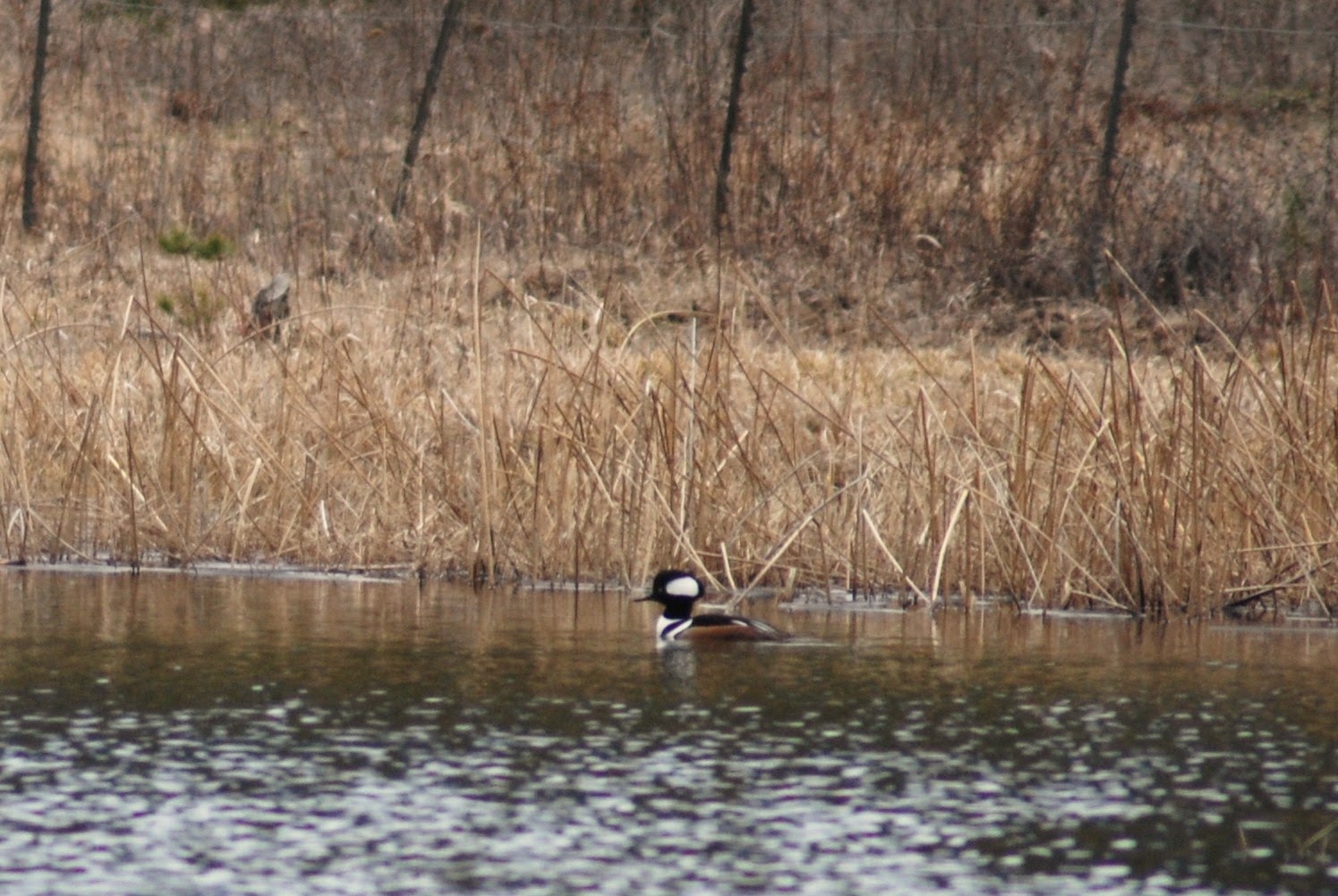 |
| Canada Geese are Dabblers |
 |
| Mergansers are Divers |
 |
| Concentric Rings From Diving |
 |
| Fully Inflated Hood |
 |
| Walking on Water for Take Off |
 |
| Flattening for Flight |
 |
| Is That a Lady Merganser Perhaps? |
The hooded merganser is one of the smallest divers; diminutive as buffleheads. In fact, I often confuse the two because first, I see is a flash of white and second, I notice concentric rings of diving.
Last year I confused the male hooded merganser for a male wood duck. They have similar striking bold patterns, but wood ducks are dabblers. Since then, I also learned to recognize the long, thin saw-bill and crest of mergansers in silhouette.
The diver in the 'hood is definitely a hooded merganser and his hood is on display. Like a modified low-rider with hydraulic suspension, the male can inflate his impressive crest of black and white. Imagine that--a breeding male with the ability to inflate his head.
He's can also walk on water. Mergansers have thin wings that whistle in flight and run across the surface of the pond as if it were an airstrip. In flight, the hooded merganser appears flat, in opposition to his puffed hood.
The diver in the 'hood seems solitary. Another fact that I've gleaned since my first summer on Elmira Pond, is that hooded mergansers nest in trees, like wood ducks. I actually witnessed the emergence of merganser babies from an old aspen across the fields of the Bluebird Ranch.
Yet a horrific scene unfolded, as babies tumbled from the tree nest. One of the Pack River bald eagles swooped low and nabbed them for lunch. Babies on the pond are vulnerable to predators.
Sharing breakfast with my youngest daughter a few weeks ago, we watched the lake by Samuel's Corners. It's the only gas station in our area and they serve home-made breakfast, thick local-beef burgers and decent coffee. We got to swapping stories with the waitress, and it seems that those Pack River bald eagles have a taste for baby duck.
But miracles do happen. Later in the summer, after I thought the mergansers left, I started to notice a solitary Lady Merganser. After much eye-squinting, internet gawking, bino scoping and bird-book flipping, I recognized her as a female hooded merganser. She has a regal crest of cinnamon. Well into July, her young brood joined her on Elmira Pond.
Now remember, I mistook the victims of the May eagle massacre for wood ducks. Was this what remained of her nest or was this a new hatch? I'm not certain.
But I am certain that a male now roosts upon the waters in this 'hood. With head inflated, he's waiting for his lady, looking mighty fine. How can a female that by? We'll keep a vigilant watch.

How beautiful, photos and storytelling. The walking on water image is the best of all. I would love to see that occur.
ReplyDeleteThanks, Ruth! It's interesting how much more I notice once I begin to understand what I'm seeing. The water-walking was cool to see!
DeleteThat walking on water shot is awesome, Charli.
ReplyDeleteThanks, Susie!
DeleteVery special - walking on water and inflating heads. Amazing. You have some very talented wildlife at your pond.
ReplyDeleteAnd since then, I've been noticing when his head deflates which is a little weird, but really makes his crest look more like a wood duck's. He's inflated and deflated twice already today. Talent, indeed.
DeleteOh, wow! The do look like wood ducks! Beautiful
ReplyDeleteI'm glad you think they do, too! Last year I was horrible at identifying the ducks. Seems that I'm learning to notice the differences, even with the females.
DeleteThese are fantastic photos. I especially love the photo of the take-off - amazing.
ReplyDeleteThanks! I remember when I shot the photo I was concerned because I startled the merganser. Now I realize it was a good capture (and he came back).
DeleteWe also are able to enjoy these in our lake, the young ones will soon be trailing along between their devoted parents very soon.
ReplyDeleteWonderful! Does the male stay around, then? I think the eagle got the male that was here last year as I only saw the female after that, but seems a few of her brood survived the attack. But I never saw the male after the eagle incident.
Delete